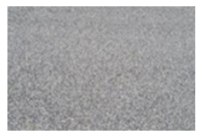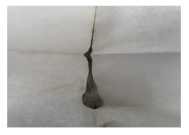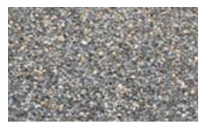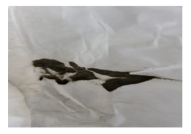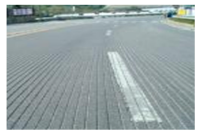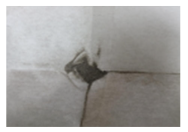Abstract
This study explores the correlation between road surface texture, including microtexture (texture depth) and macrotexture (wavelength) in asphalt pavement, and suspended dust generation on asphalt pavements. A detailed analysis of various pavement types, including Hot Mix Asphalt (HMA) and porous pavement, was conducted to assess their impact on dust load and concentration. For HMA pavements, deeper texture depths led to a higher dust load and concentration, attributed to the impermeable nature of the material, which causes dust to become easily suspended in the air. Conversely, porous pavements, which have air gaps in their surface layers, showed reduced dust suspension despite a higher dust load, due to the ability of these voids to trap dust and minimize air-pumping effects from tire–road contact. The study found that a macrotexture depth (MTD) exceeding 1.7 mm stabilized dust concentration, while higher surface wavelengths and silt load (sL) values above 0.1 g/m2 significantly contributed to dust suspension. These findings suggest that optimizing road surface texture and aggregate size, considering the voids and depth, can help reduce suspended dust, providing a balance between road safety and environmental management. This research offers valuable insights for designing pavements that mitigate air pollution while maintaining functional performance.
1. Introduction
Particulate matter (PM), with diameters smaller than 10 μm, poses severe health risks, including respiratory failure and mental health disorders [1]. Road dust (RD), a primary contributor to urban air pollution, is both generated and dispersed by vehicular activity. It consists of exhaust emissions (EEs) from internal combustion engines and non-exhaust emissions (NEEs) induced by vehicle movement, such as tire wear, brake wear, and road surface abrasion [2,3]. Extensive research has focused on developing regression models for road-suspended dust to establish quantitative relationships between dust concentration and the governing dispersion factors, but there are empirical limitations [4,5]. The present study introduces an enhanced regression model for road-suspended dust that integrates a more comprehensive assessment of surface texture characteristics [4,6]. The findings indicate that macrotexture plays a pivotal role in dust retention, both in its suspended and resuspended states [6]. The volume and geometry of voids within pavement macrotexture significantly influence non-exhaust emissions generated through tire–road interactions. Since the mean texture depth (MTD) is a volumetric parameter of road surface texture, it provides a robust metric for evaluating dust accumulation relative to surface roughness [7,8]. Furthermore, this study suggests that optimizing surface texture can mitigate suspended dust levels by enhancing the capacity of texture voids to trap particulate matter, thereby reducing tire-induced air suspension forces and the overall quantity of airborne dust [9,10]. While porous asphalt pavement (PP) generally exhibits lower dust suspension than dense-graded asphalt due to its interconnected voids and enhanced macrotexture, further research is necessary to quantitatively characterize surface texture parameters such as texture depth and wavelength [8,10]. In this context, the current study investigates the relationship between suspended dust concentration and surface texture characteristics by measuring texture depth and wavelength across various concrete pavement sections. The transport and accumulation of road dust—and consequently PM10—are influenced by road surface texture [11], pavement condition, and meteorological variables [9]. Most studies correlating these factors with PM emissions originate from Nordic countries and primarily examine different types of Stone Mastic Asphalts (SMAs). For instance, prior research has demonstrated a clear relationship between mineral dust load and surface macrotexture, revealing that dust accumulation increases following resurfacing with a rougher macrotexture [10]. Additionally, road traffic noise is generated by the interaction between tires and pavement surfaces. One effective strategy for reducing traffic noise is replacing dense-graded pavements (e.g., SMA, HMA) with open-graded alternatives such as porous asphalt concrete (PP) [12,13]. The interconnected air voids in porous pavements attenuate specific noise generation mechanisms, contributing to noise reduction [13]. While porous pavements are widely utilized in countries like the Netherlands, their adoption is limited in regions where studded tires are prevalent due to durability concerns [14]. The service life of porous pavements is generally shorter than that of dense-graded pavements, primarily due to the raveling—the progressive loss of aggregate from the pavement surface—caused by construction deficiencies, aging, and freeze–thaw cycles [15]. These findings suggest that, even without directly sampling the dust load, pavement surfaces function as particle traps until voids become saturated with particulate matter [13,16].
Furthermore, the study suggests that surface texture manipulation can reduce suspended dust levels by improving the ability of texture voids to capture dust particles, thereby decreasing both the air suspension force exerted by the tires and the overall quantity of dust suspended in the air. While PP typically results in lower dust suspension compared to dense asphalt due to its air gaps and deeper texture, further research is needed to quantitatively characterize surface texture features, such as texture depth and wavelength. Therefore, this study investigates the relationship between suspended dust concentration and surface texture characteristics by measuring texture depth and wavelength across various asphalt pavement sections.
2. Materials and Methods
2.1. Study Area
To verify the hypothesis regarding road dust emissions, experiments were conducted at the Yeoncheon Social Overhead Capital (SOC) Center of the Construction Technology Research Institute (Site A) in South Korea, focusing on PP and Hot Mix Asphalt (HMA). Additionally, data on road-suspended dust were collected for HMA, asphalt grooving (horizontal), and asphalt grooving (longitudinal) pavements at the Yeoju test road on the Korea Expressway (Site B). Furthermore, to gather various data on HMA, which is commonly used in South Korea, as well as the characteristics of tire-surface suspended dust and dust emissions, measurements were taken for the three types of asphalt HMA applied in Yongin City. Generally, the longitudinal grooving shape is not used in asphalt pavements; this section was installed specifically for testing to investigate the relationship between road surface texture and suspended dust.
As shown in Figure 1, measurements were conducted from May to September 2023, during which a similar concentration of background dust was observed to assess suspended dust levels across various pavement types, excluding the influence of background dust. During the measurement period, no significant weather events, such as rainfall exceeding 0.01 inches, occurred, which could substantially impact fine dust concentrations [5]. To further minimize external influences, an additional set of measurements was taken on non-operational traffic sections of paved roads. Simultaneously, background PM10 data were collected from the urban observatory monitoring system to analyze road-suspended dust related to surface texture. This methodology enabled the evaluation of suspended road dust concentrations in relation to road texture and silt loading (sL) within the same asphalt pavement types.
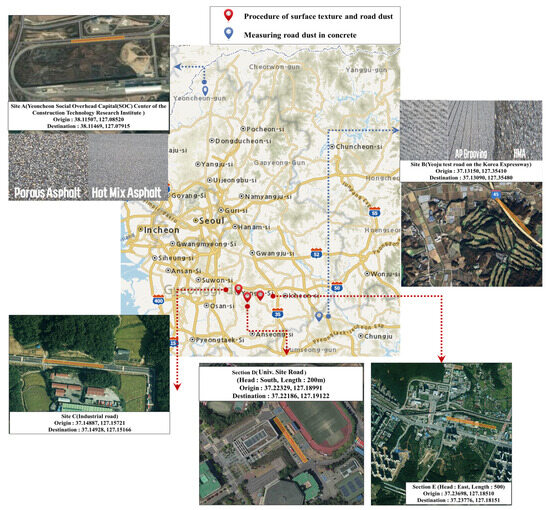
Figure 1.
Study area in South Korea (test road A,B and Hot Mix Asphalt pavement of C~E).
2.2. Concept of Microtexture and Macrotexture of Asphalt Pavement
In general, the road surface structure of asphalt pavement is characterized by both microtexture (texture depth) and macrotexture (wavelength) [12,13]. Due to the irregular placement of aggregates, both texture depth and wavelength vary at each measurement point. This is described in Figure 2. Therefore, it is crucial to collect diverse data [13]. In the case of concrete pavements, the shape of coarse aggregates plays a significant role in determining the microtexture of the road surface, while other factors primarily contribute to the formation of the macrotexture [12]. Asphalt pavement, in particular, exhibits irregularities on the road surface with random wavelengths and texture depths, which may lead to dust being suspended in the air by wind or vehicle traffic [17]. Vehicle traffic generates air pumping with wind speeds of 2.2 m/s at 50 km/h [6]. Consequently, road texture is composed of both wavelength and texture depth, which are expressed as microtexture and macrotexture. It is known that pavements with rough textures exhibit the highest friction coefficient, providing the best friction for expected braking forces. Furthermore, in relation to road texture depth, various road texture wavelengths are quantified, as they occur within a single section of road pavement. The number of inflection points according to the road texture wavelength is defined as the Peak Number (PN) [18,19].

Figure 2.
Concept of texture depth and wavelength of asphalt pavement.
The road surface texture characteristics were quantified based on wavelength and texture depth, with measurements taken across various pavement types within the designated sections. The texture depth, which represents the macrotexture of pavement, was averaged for each pavement type using the Sand Patch Test (SPT) in accordance with ASTM E 965. The SPT involves spreading 100% of the sand retained on the No. 100 sieve across the road surface using a 25 cm3 volume of sand, as shown in Figure 3a. The sand is evenly distributed in a circular pattern, and the diameter of the spread is measured to calculate the texture depth [20]. In this methodology, V denotes the volume of sand, and D represents the diameter of the sand dispersion on the surface. Both the SPT and wavelength tests were performed at 3 m intervals along the left–center–right wheel paths of the pavement section, with the results subsequently averaged for the final measurements.
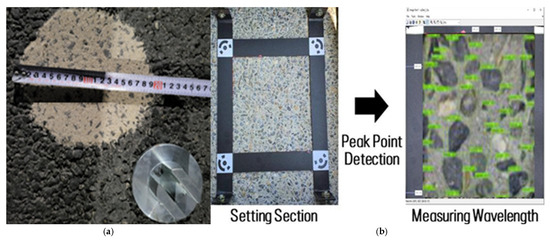
Figure 3.
Measuring method of road surface texture: (a) texture depth using Sand Patch Test, (b) wavelength using peak point detection.
The following is an equation of the mean texture depth (MTD):
V: Volume of sand
D: Diameter of sand dispersed on the surface
The method of measuring the wavelength is evaluated through aggregate exposure using the Exposed Aggregate Number (EAN), which is calculated with specialized equipment and software. The measurement apparatus captures superimposed images, which are then reconstructed into a three-dimensional surface texture, allowing the aggregate exposure to be visualized, as shown in Figure 3b. For each section, a 100 cm × 60 cm area is divided into 24 segments, and photos are automatically taken using a program installed on a laptop [19]. Through this process, the wavelength of the road surface is determined by measuring the aggregate exposure in the designated pavement sections. To calculate the average distance between aggregates, a 5 mm width of the road surface is measured, and the peak points of the aggregates are identified over a 300 mm length [18].
2.3. Silt Loading (sL) and Suspended Road Dust Measurement
Suspended road dust refers to dust particles that remain airborne for extended periods as silt (sL) accumulates on the road surface. Road dust is quantified by measuring the weight of particles smaller than 75 µm deposited on a unit area (m2) of the road. According to the EPA AP-42 Appendix C 1,2 standards, the particle size characteristics of the dust, particularly the mass of particles smaller than 75 µm, were analyzed. A bag filter, capable of collecting dust particles larger than 1.0 µm, was installed in a portable industrial cleaner to comprehensively collect dust from the road surface [21,22]. The resuspended PM10 measurement system employs an optical sensor that continuously inhales air every second to determine the PM10 concentration on the road via inlets mounted on the front (hood) and rear (right front wheel) of the vehicle [23].
- Vehicle specifications: 2016 SUV Sportage 2.02 WD, Tire Model 225/60R17.
- PM10 Sensor: the 8530 Dust-Trak Optical PM Sensor Model (TSI Company, Shoreview, MI, USA) with a PM10 inlet is a portable device that can measure the concentrations of various sizes of dust particles in real time, such as PM10 and PM2.5.
- Inlet: The right tire line inlet is 175 mm above the ground and 50 mm behind the tires. The PM10 concentration (Ci) obtained from the back of the tires during movement indicates that the air velocity measured along the center of the tires was not affected significantly by the surrounding wind direction at a distance less than 100 mm from the tires [21].
- Uniform Velocity Flow Sampling Inhalation: a vacuum pump is controlled by a customized suction port to adjust the pressure of the suction port appropriately, thereby producing a pressure-free suction port, so the air flow that is being sampled has the same fluid flow as the surrounding air flow.
- Data Collection System: laptop computers were used to collect and transmit Dust-Trak data at one-second intervals.
- Monitoring Camera: a camera capable of monitoring the inside and outside of the vehicle can be installed to visually cross-verify the measurement data in the driving section and monitor the speed observed on the vehicle’s speedometer.
The 50 km/h driving speed was chosen as it reflects the typical operating speed for vehicles on urban and arterial roads in the Republic of Korea. It is not a strict speed limit but rather a representative average speed that aligns with national road design guidelines and ensures the safe and stable operation of the measuring vehicle and equipment. Additionally, maintaining a consistent speed throughout all measurements helps minimize variability and ensures reliable comparison across different sites. In accordance with the dust sampling methodology established by the U.S. EPA for measuring sL on road surfaces, vacuum sampling was conducted over a 100 m road segment. A total of 33 samples were collected from a 3 × 3.5 m (length × width) area, with an additional four samples taken from a 25 × 3.5 m (length × width) area, ensuring continuous sampling along the entire 100 m stretch. The 3 m width used in this methodology was selected based on the industrial vacuum cleaner inlet, which is 30 cm in length and is designed for 10 individual measurements. Specifically, the 3 m length corresponds to 10 consecutive measurements, each using the 0.3 m inlet of the vacuum cleaners recommended by the EPA. This minimum sampling length aligns with the EPA’s guidelines, which suggest conducting at least 10 measurements to improve the reliability of dust collection [19]. The 100 m sampling range was chosen to correspond to the minimum distance required to collect 5 to 6 data points while using the TRAKER systems during a 50 km/h vehicle [20]. This ensures that a sufficient number of samples can be obtained, providing a comprehensive representation of dust concentrations.
Subsequently, the IQR (Interquartile Range) method was employed to analyze the distribution of sL and suspended road dust across the sampling locations. The IQR represents the range between the 25th percentile (Q1) and the 75th percentile (Q3) of the data, with the difference (Q3-Q1) forming the IQR. The minimum limit is calculated by subtracting 1.5 times the IQR from Q1, while the maximum limit is determined by adding 1.5 times the IQR to Q3. In the case of the Helos and Rodos laser particle size analyzer, when the collected silt is placed into the equipment, the system can measure dust particles smaller than 10 µm and 70 µm. For sL, the dust content is considered as particles smaller than 75 µm, with particles below 10 µm recorded as PM10 for subsequent analysis, referred to as PM10 content (%) [24].
2.4. Assumption
The emission of dust particles resulting from tire and brake wear is retained within the surface texture and subsequently deposited onto the pavement. This retention of dust and contaminants is predominantly influenced by traffic-induced turbulence, with particles being captured within the surface texture. Traffic turbulence refers to the airflow generated as a vehicle moves, facilitating the interaction between the tires and the road surface. The texture of the road surface plays a critical role in tire–pavement interaction, deviating from a uniformly smooth surface. The characteristics of the road texture, along with the dust generation mechanisms, are governed by both the wavelength and texture depth of the surface, which are determined by the specific attributes of the texture. The hypothesis related to surface texture explored in this study is illustrated in Figure 4.
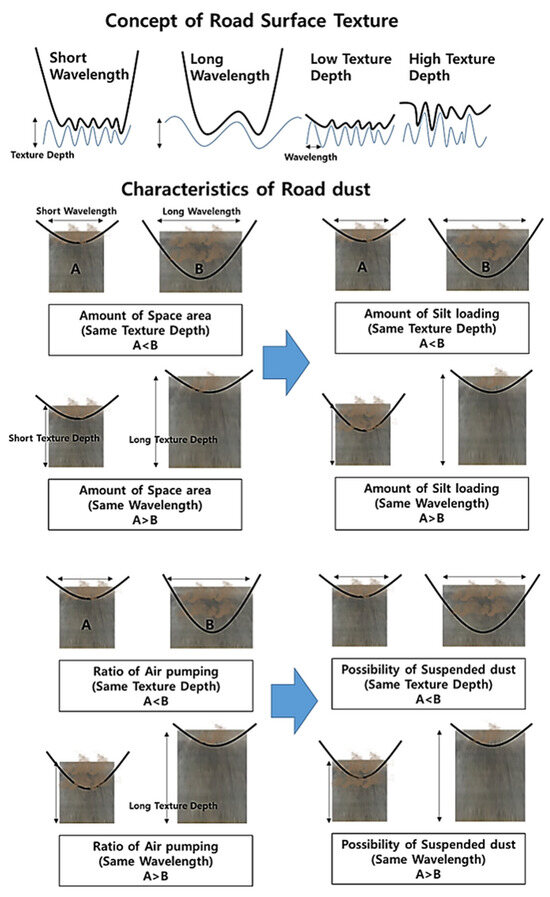
Figure 4.
Assumption of road surface texture and dust generation.
3. Results
3.1. Relationship Between Suspended Dust and Silt Loading in HMA
The spatial distribution of the sL value in relation to suspended dust, measured through tests conducted at the C~E sites, exhibited varying values for each collection point. To further analyze the spatial contamination, the sL value was measured, and the distribution of contamination was examined using debris measurements taken at one-second intervals through the TRAKER system [23,24]. To minimize errors, sL was measured immediately after the suspended dust was recorded. All selected data were obtained under consistent conditions, ensuring uniformity across the measurement section, including the starting point, acceleration, constant speed, and endpoint. The concentration of suspended dust corresponding to the sL value was measured based on the 50 km/h operational guidelines [23,24]. The correlation between the suspended dust concentration and the average sL across the entire C~E site section was found to be strong (0.84), as shown in Figure 5. The concentration of suspended dust increased in accordance with the sL value. However, considering the threshold of 0.05 g/m2 in South Korea, the sL value appeared excessively high to be representative of urban areas. Under these conditions, the R2 value was 0.22. Nevertheless, the results support the notion that the sL value can be used as an indicator of road-suspended dust while driving.
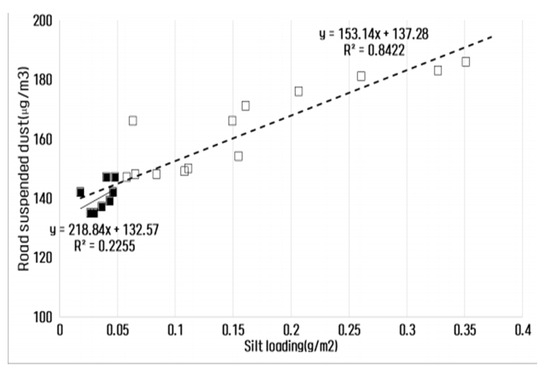
Figure 5.
Relationship between silt loading and dust in measurement sections.
3.2. Criteria for Eligible Data for the Road-Suspended Dust and Texture Factors
The road dust emission measurement system quantifies the sL values at the site and records dust concentrations at 1 s intervals using DustTrak equipment via a mobile laboratory on pavements, correlating these values with the sL data. The effect of sL (dust inhalation due to the vacuum cleaner) could influence the data when measuring, potentially introducing measurements outside the device’s range and affecting the correlation analysis. To mitigate these factors and select valid data, a well-defined data processing criterion is essential. Table 1 presents the suspended dust values measured five times before and after sL sampling at speeds of 30–50 km/h to minimize measurement errors. The average resuspended dust value before sL collection was 35.4, 52.8, and 77 μg/m3, while after sL collection, the average values decreased by 88.35% to 10.3, 12.8, and 17.2 μg/m3, respectively. The average reduction rate of road-suspended dust was 74.8%. Therefore, measuring suspended dust after sL collection may introduce limitations when determining dust concentrations based on sL. To summarize, the data acquisition process incorporates four key components aimed at minimizing the loss of sL data, as follows:

Table 1.
Results of road-suspended dust before and after sampling silt loading (Vacuum Method).
- Suspended Dust Measurement: The section is initially measured for background dust concentration before the sL measurement. If the difference between the background dust concentration and the suspended dust concentration is negative, it is attributed to the influence of surrounding vehicles and excluded from the data.
- sL Measurement: subsequently, the sL value is measured to determine the amount of dust per unit area within the section.
- Road Surface Texture Measurement: after the dust collection process, the road surface texture depth and wavelength are measured to evaluate the texture of the road surface with a clean status of texture depth and distance of aggregate.
For silt loading (sL), dust collection was carried out over a 3 m section using an advanced sampling technique, with the aim of correlating suspended dust concentrations with specific sL values. This 3 m length corresponds to 10 consecutive measurements, each covering 0.3 m, which is consistent with the inlet length of industrial vacuum cleaners employed by the EPA. It is recommended to perform at least 10 measurements to improve the reliability of the dust collection process [23,24]. During texture measurement, the average wavelength was determined by evaluating aggregate exposure using specialized equipment across various asphalt pavement types. Furthermore, the average road surface texture depth was measured using the Sand Patch Test (SPT) method. To ensure thorough data collection, approximately 100 data points were recorded along a 100 m section, with the front and rear sections separated to minimize the influence of continuous road segments throughout the entire length. The step is described in Figure 6.
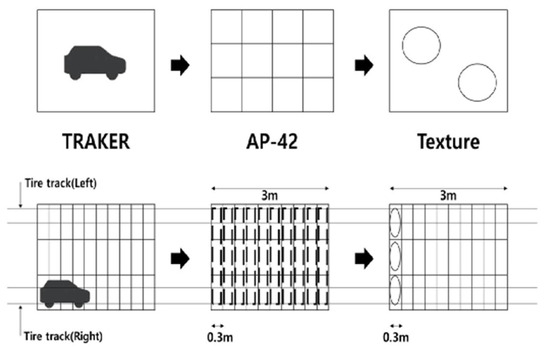
Figure 6.
Process for eligible data for the road dust and surface texture with minimum loss.
3.3. Average Texture Depth and Wavelength on Different Type of Asphalt Pavement
The average wavelength was determined by analyzing aggregate exposure using specialized measurement equipment, while the mean texture depth (MTD) was assessed through the Sand Patch Test (SPT) method. As presented in Table 2, the average wavelength for Hot Mix Asphalt (HMA) pavement at Site C was 3.854 mm, whereas Sites D and E exhibited comparable values of 4.291 mm and 4.391 mm, respectively. The corresponding MTD values were 0.63 mm, 0.99 mm, and 0.8 mm, indicating variations in surface texture characteristics. For porous pavement (PP), the average wavelength measured 4.6 mm, with an MTD of 1.71 mm, signifying a relatively deeper surface texture. In contrast, HMA at the same location demonstrated a significantly lower MTD of 0.45 mm. At Site B, the average wavelength remained consistent at 3.4 mm across all pavement types. However, while HMA exhibited an MTD of 0.5 mm, asphalt grooving pavement—both longitudinal and transverse—demonstrated a notably higher MTD of 1.01 mm, suggesting an enhanced surface macrotexture due to the grooving process.

Table 2.
Measurement results of asphalt surface texture in test road.
These findings underscore the influence of pavement type and surface treatment on texture depth, which is a critical factor in skid resistance and surface drainage performance. The results further reinforce this, as variations in MTD were observed even among HMA pavements, indicating differences in surface deterioration and wear progression depending on site-specific conditions and material properties.
The measurement of road-suspended dust was conducted using a mobile laboratory, assessing dust emission factors for both porous pavement (PP) and Hot Mix Asphalt (HMA) pavement over a 150 m section at Site A. The TRAKER-based method, employing an inlet-equipped system, measured road dust concentrations at a driving speed of 50 km/h. Described in Table 3, among the sites, Site D exhibited the highest road dust load, with an sL value of 0.224.26 g/m2 and an average PM10 content of 6.82%, indicating a significant accumulation of dust. This site, located on a university road without active cleaning measures, depends entirely on natural environmental factors (e.g., rain, snow) for dust removal, which contributes to the elevated dust levels. In contrast, Site C recorded the lowest sL value of 0.0484 g/m2 and the lowest PM₁₀ content, reflecting minimal suspended dust concentration under the same driving conditions.

Table 3.
Road dust results of asphalt pavement in test road.
At Site A, where both porous pavement (PP) and Hot Mix Asphalt (HMA) were evaluated, significant differences were observed. The PP pavement exhibited a higher sL value of 0.1121 g/m2 compared to 0.062 g/m2 for HMA. Despite this higher road dust load, the PM₁₀ content of PP (4.28%) was notably lower than that of HMA (15.84%), suggesting that PP retains larger particles within its surface voids, which reduces the resuspension of fine particulate matter. At Site B, where HMA and asphalt grooving pavements were compared, variations in dust emissions based on surface treatment were evident. The sL value for HMA was 0.0199 g/m2, while asphalt grooving (horizontal) recorded 0.1113 g/m2, and asphalt grooving (longitudinal) recorded the highest at 0.1671 g/m2. Despite these differences in sL values, the PM10 content remained relatively low across all pavement types, ranging from 3.21% to 5.69%, suggesting that the majority of suspended material consisted of larger particles that are less likely to become airborne.
Deeper surface textures are associated with increased road wear, contributing to higher dust loads and greater suspended dust generation. Sites C through to E exhibited similar trends, where variations in sL values and PM10 content suggest that road conditions, maintenance practices, and environmental exposure significantly influence dust accumulation and resuspension. For sL measurements, dust collection was conducted over a 3 m section using an enhanced sampling technique to ensure accurate correlation with suspended dust concentrations. Texture data were recorded at 3 m intervals over a 100 m section, with separate measurements for the front and rear to minimize the influence of continuous road segments. This method was applied consistently across the full 150 m test sections for both PP and HMA pavements.
Additionally, background dust concentrations were recorded at the nearest observatory during measurements to account for ambient environmental conditions. Across all sites, background dust levels exhibited minor fluctuations, with TR values ranging from 61.47 μg/m3 to 70.3 μg/m3 and OB values between 61 μg/m3 and 66.75 μg/m3. These background measurements suggest that site-specific road dust variations are predominantly influenced by pavement type and road maintenance conditions, rather than external environmental factors alone. These findings underscore the significant impact of pavement type and surface treatment on road dust emissions, highlighting the need for targeted maintenance strategies aimed at mitigating particulate matter resuspension and improving air quality in urban environments.
3.4. Analysis of Dust Generation Based on Mean Texture Depth
For the same pavement type of HMA, the relationship between sL, MTD, and suspended dust exhibits a positive correlation, suggesting that higher MTD levels result in a greater accumulation of sL on the surface, which subsequently leads to an increase in suspended dust levels in the air (Figure 7). Upon analyzing the concentration of suspended dust for HMA, it was found that although the MTD value was lower compared to other asphalt pavements, the suspended dust concentration was higher. This is attributed to the smoothness of the HMA surface, which allows dust (dust load) particles to be easily suspended in the air with minimal resistance. Additionally, this phenomenon is influenced by driving speed, as higher speeds generate stronger air turbulence, enhancing the suspension of dust particles.
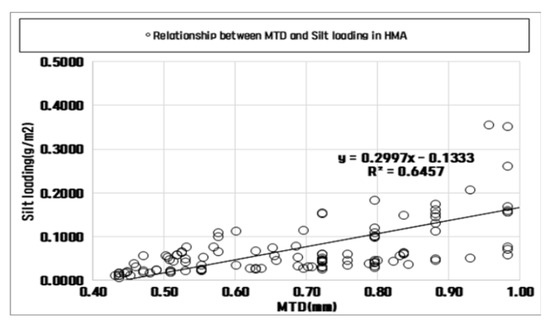
Figure 7.
Relationship between mean texture depth with silt loading in Hot Mix Asphalt.
To quantify the concentration of suspended dust in relation to texture characteristics, the variation in suspended dust concentration across different grades was analyzed, as presented in Table 4. By identifying the suspended dust concentration based on these influencing factors, the relationship between macrotexture depth (MTD) and suspended dust was quantified. MTD management strategies for controlling suspended dust were proposed, assuming a constant dust concentration for a given MTD. The analysis categorized MTD values into high, middle, and low groups to assess the impact of road texture on suspended dust. Thus, the change in suspended dust concentration generated according to each grade was analyzed by classifying MTD into high, middle, and low categories. As shown in Table 4, MTD values were classified as low (≤0.7 mm), middle (0.7–1.1 mm), and high (≥1.1 mm). For sL, the high and middle dust loads were classified using urban roads and 1 g/m2 in Incheon, based on a threshold of 0.05 g/m2 in accordance with the dust load levels observed in city center areas [25].

Table 4.
Analysis of dividing grade with MTD, silt loading, and wavelength.
By identifying the concentration of suspended dust based on these divided influencing factors, the relationship between MTD and suspended dust was quantified, and MTD management measures were suggested, assuming the dust concentration remains constant for a given MTD. In the case of asphalt pavement, where there are no predefined grooves like those in asphalt pavement, the wavelength was divided into cases of 4 or more and cases of 4 or fewer.
3.5. Relationship Between Mean Texture Depth with Road-Suspended Dust
The suspended dust generation mechanism related to surface texture occurs when the tires rub against the road surface, making contact with the peak levels of the texture [26,27]. This results in dust particles becoming suspended in the air. To better understand this phenomenon, an additional analysis was performed on the wavelength of the road surface, providing a more quantitative measure of how the tires interact with the peak levels. The results of this analysis, which examined the relationship between MTD, wavelength, and suspended dust concentration, indicated that both the MTD and wavelength are influenced by the aggregate particle size and distance. The patterns observed further support this conclusion, demonstrating the role of aggregate size in determining the texture of the road surface and its impact on dust suspension.
To analyze the correlation between suspended dust concentration and MTD for different asphalt pavement series, the change in suspended dust concentration across each grade was first examined by categorizing MTD values into high, middle, and low ranges. These grades were specifically designed to assess the concentration of suspended dust generated by the high phase of MTD, similar to the levels of PM10 content and sL. As shown in Figure 8, the suspended dust concentration generated at MTD values between 0.7 mm and 0.9 mm and those between 0.9 mm and 1.1 mm was comparable. This similarity led to the conclusion that MTD values in the range of 0.7 mm to 1.1 mm correspond to a similar level of suspended dust generation. Consequently, the analysis was conducted by dividing the MTD stages into two categories: 0.7 mm and 1.1 mm.
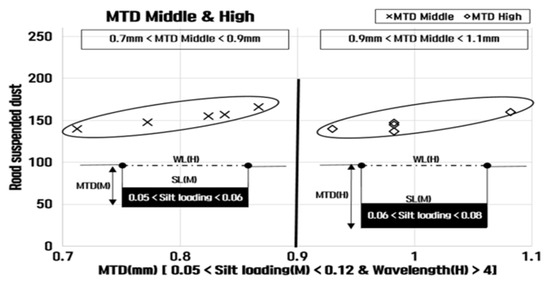
Figure 8.
Road-suspended dust based on the level of MTD in silt loading 0.05~0.12 g/m2.
Figure 9 presents the results of analyzing suspended dust concentration according to MTD at low, middle, and high grades of sL. The analysis aims to identify whether an inflection point occurs when MTD surpasses a certain threshold, which would suggest that the suspended dust concentration stabilizes as sL reaches a level where it no longer becomes airborne with increasing texture depth. Managing texture depth in relation to suspended dust concentration is crucial for controlling dust levels effectively. The suspended dust concentration corresponding to low dust loads (sL of 0.05 g/m2 or less) is illustrated. The analysis reveals that, with lower MTD values, suspended dust concentration is higher. Specifically, the longitudinal grooving of asphalt pavement displayed the highest suspended dust concentration in the medium short term. This is attributed to the air pumping caused by the grooving shape when tires make contact with the road surface, resulting in higher suspension levels. Furthermore, it was observed that as MTD increased, the suspended dust concentration gradually decreased.
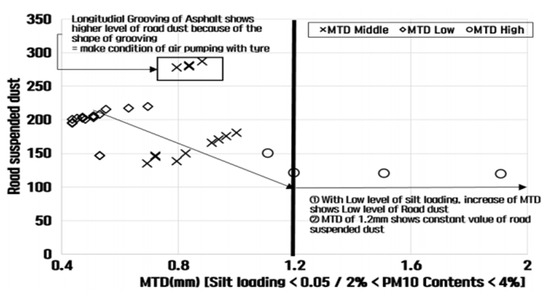
Figure 9.
Road-suspended dust based on the level of MTD within low level of silt loading.
However, once the MTD reached 1.2 mm, the concentration of suspended dust remained constant, suggesting that a texture depth of 1.2 mm or more is sufficient to maintain suspended dust at a stable level during tire–road contact. As the MTD increased, the concentration of road-suspended dust tended to decrease. At this time, depending on the type of pavement, HMA, asphalt grooving, and PP appeared lower than the MTD value presented above, the higher the suspended dust concentration, and in the case of PP, the suspended dust concentration was relatively low due to the voids [28,29]. So, the concentration of dust in the asphalt section is judged to have a statistically clear correlation. The suspended dust generation mechanism according to this road surface organization is judged to cause tire deformation on the road surface momentarily as the tires rotate with the peak level existing on the road surface, resulting in suspended dust caused by the tires. Therefore, in the case of the same pavement conditions, the higher the peak level of the MTD, the more dust can be suspended on the road surface, increasing the dust concentration. Since the peak level of the road surface texture increases as the MTD increases, it is judged that management is necessary to reduce dust of suspension.
Figure 10 presents the analysis of suspended dust concentration according to sL during the MTD stage. The results show no significant difference in dust concentration between the low sL value and the middle stage. It is observed that the sL level, ranging from 0 to 0.12 g/m2, tends to accumulate and remain stable within the MTD range of 0.7 to 1.1 mm. However, when the sL level exceeds 0.12 g/m2, the concentration of suspended dust increases. This suggests that dust levels can be controlled by maintaining a slightly deeper MTD, which helps to manage the amount of suspended dust in the air effectively.
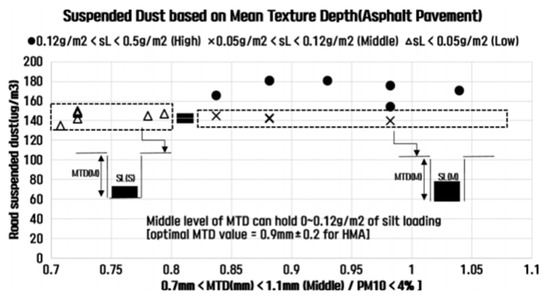
Figure 10.
Road-suspended dust based on the level of middle MTD and its threshold.
As shown in Figure 11, the suspended dust concentration increased with sL during the MTD phase, but as sL continued to rise, the MTD value appeared to stabilize the dust concentration. This finding was evaluated as indicating the optimal MTD for managing suspended dust. Specifically, it was observed that road dust concentration remained constant at MTD values of 1.2 mm in the lower sL section, 1.5 mm in the middle section, and 2 mm in the high section. The elevated MTD sections were associated with porous pavement on asphalt pavement, suggesting that an MTD value of at least 1.5 mm is necessary for effective road dust management. Additionally, when examining HMA pavement, it was found that the concentration of suspended dust, particularly at higher PM10 content levels, was more significant [24]. Therefore, PM10 content may be considered a more valid factor than MTD when determining the concentration of suspended dust on the road. The results of correlation analysis, based on data from mobile laboratories measuring road dust while driving at 50 km/h under fixed conditions in the asphalt pavement section, further supported these conclusions.
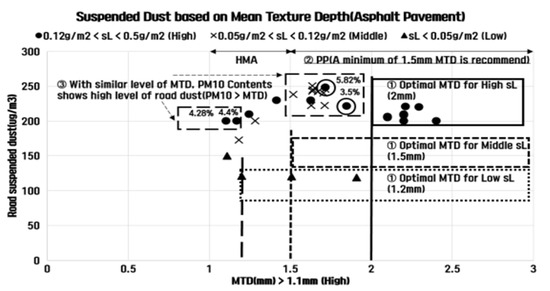
Figure 11.
Road-suspended dust based on MTD level with high sL (sL > 0.15 g/m2).
The relationship between MTD and the wavelength cycle is evident, as both road surface texture depth and wavelength are influenced by changes in aggregate particle size and its distance [30,31], as observed in previous studies. This suggests that aggregate particle size plays a significant role in determining the road surface texture and, consequently, the suspended dust concentration [30]. It can be concluded that the impact of aggregate particle size is more pronounced in asphalt pavement, with smaller maximum aggregate dimensions contributing to lower suspended dust levels. Further analysis revealed that lower MTD values, combined with higher wavelengths, result in higher suspended dust concentrations. However, the instantaneous suspension of dust caused by tire–pavement interactions and its relationship with MTD remains challenging to quantify due to the complexity of the dust resuspension mechanism. Therefore, the relationship between suspended dust and wavelength was evaluated by examining cases where the wavelength’s influence varied according to the grading of MTD and sL values. This analysis helps better understand the interplay between these factors and their impact on dust generation.
As shown in Figure 12, when the sL is low, the suspended dust concentration at the same level of PM10 content is approximately 40% lower at the low MTD compared to the middle MTD. Generally, when the MTD is low, HMA pavement is the most representative, meaning that at low MTD values and high PM10 content, suspended dust concentrations tend to be the highest. This suggests that smoother surfaces with lower texture depth (such as HMA) are more prone to dust suspension, especially when high concentrations of fine particulate matter (PM10) are present.
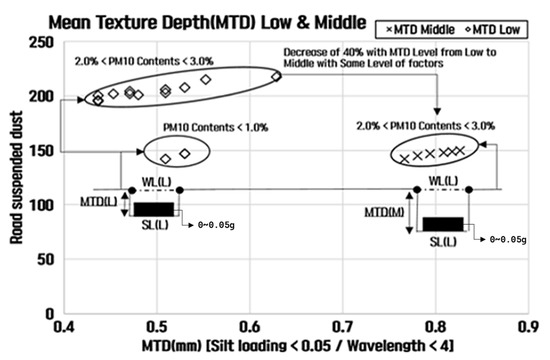
Figure 12.
Critical point of asphalt pavement MTD analyzed in terms of road-suspended dust.
As a result of analyzing the concentration of suspended dust at the middle level of MTD described in Figure 13, it was found that the sL deposited in the range of 0.05–0.08 g/m2 resulted in a moderate level of suspended dust, while at higher sL levels (0.08–0.12 g/m2), the concentration of suspended dust was significantly higher. Furthermore, the group of sL values showed a clear distinction in suspended dust levels, with values under 0.1 g/m2 exhibiting lower dust concentrations, while values exceeding 0.1 g/m2 were associated with higher suspended dust levels. This indicates that higher sL levels contribute to greater suspended dust emissions, further emphasizing the need for managing both texture depth and dust load for effective dust control.
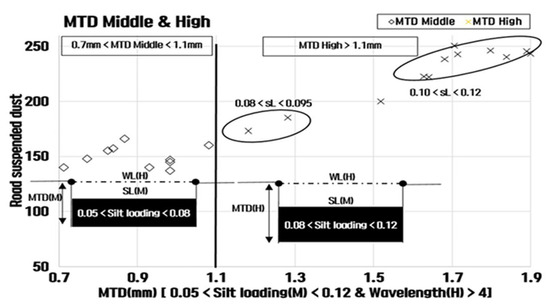
Figure 13.
Effects of road-suspended dust with MTD of middle and high.
At the highest level of MTD, exceeding 1.7 mm, the concentration of road-suspended dust remained constant regardless of further increases in MTD values. This suggests that an MTD depth of 1.7 mm is sufficient to prevent dust from becoming airborne, even when the sL is at a middle level. The deep texture created by an MTD greater than 1.7 mm effectively traps dust particles on the surface, limiting their suspension in the air. Therefore, managing road-suspended dust in areas with a high sL can be achieved by optimizing MTD, using a deeper texture depth to reduce the release of suspended dust. Furthermore, with respect to sL, an MTD of 1.7 mm was found to effectively manage middle-level sL values, while an MTD of 1.9 mm was capable of accommodating higher sL values, up to 0.12 g/m2. Although the measurement value of sL remained below 0.2 g/m2, it did not reach the highest threshold of sL. Nevertheless, these results suggest that increasing MTD can serve as an effective method for suppressing the suspension of road dust in the air, providing a practical approach for managing road dust emissions by controlling the texture depth (Figure 14).
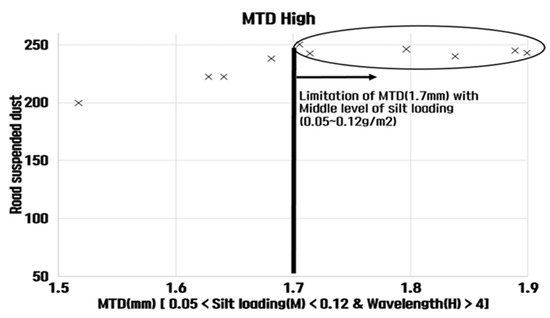
Figure 14.
Threshold of MTD with level of silt loading.
3.6. Relationship Between Wavelegnth with Road-Suspended Dust
The analysis of suspended dust generation due to road surface texture revealed that the mechanism is closely linked to the interaction between the tires and the peak levels of the road surface during rotation [13,18]. In this context, a further examination of the road surface’s wavelength cycle was conducted to quantify how these interactions contribute to suspended dust generation. The analysis, which examined the correlation between MTD, wavelength, and suspended dust concentration, found that MTD and wavelength cycles are influenced by aggregate particle size. This relationship is evident in the patterns observed in asphalt pavement, where the two factors are correlated. It was determined that a smaller maximum aggregate size in asphalt pavement tends to reduce suspended dust. Furthermore, the analysis indicated that lower MTD values and higher wavelengths are associated with higher suspended dust concentrations.
However, capturing the exact relationship between suspended dust caused by air pumping and MTD remains challenging. Despite this, evaluating the relationship between suspended dust and wavelength based on the rating of MTD and sL provides valuable insight into how surface texture and road conditions affect dust suspension. This underscores the need for further research to understand the nuanced interactions between these factors and their role in road dust management. However, when the sL value shows a high dust load, minimizing the wavelength is crucial for reducing the suspended dust concentration (Figure 15). This highlights the importance of controlling the surface texture to manage road dust, supporting the relationship between surface texture and road noise [7,13]. By minimizing the gap between aggregates, the peak level can be reduced, thus minimizing the wavelength of asphalt pavement. This method could effectively help manage suspended dust in areas with a high dust load, such as industrial zones.
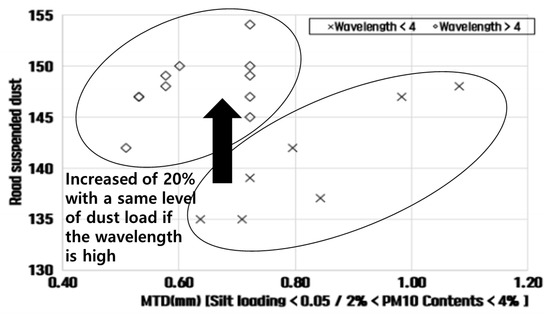
Figure 15.
Difference between road-suspended dust concentration based on level of wavelength.
Further analysis conducted on the middle range of sL (0.05 to 0.12 g/m2) revealed that when the wavelength exceeds four, the suspended dust concentration is approximately 30% higher than when the wavelength is below four, as shown in Figure 16. This suggests that a higher wavelength leads to a greater accumulation of dust on the surface, as the sL in the higher wavelength range contains more dust. When the tires contact the road surface, the air pumping effect is more pronounced [25], resulting in a larger amount of dust being suspended in the air. Therefore, managing the wavelength and surface texture can be an effective strategy for controlling dust suspension in areas with a high road dust load. Indeed, the gap between aggregates plays a significant role in the suspension of dust. When the wavelength is higher, the gap between the aggregates increases, creating more space for dust particles to become airborne. This larger gap allows for greater air movement between the road surface and the tires, increasing the potential for dust to be lifted and suspended in the air as a result of Figure 16. Therefore, it can be concluded that the wavelength does have an effect on the concentration of suspended dust, with higher wavelengths facilitating more dust suspension due to the larger gaps between the aggregates. Reducing the wavelength by minimizing the gap between aggregates can thus be a key strategy in controlling suspended dust concentrations, especially in areas with a high road dust load.
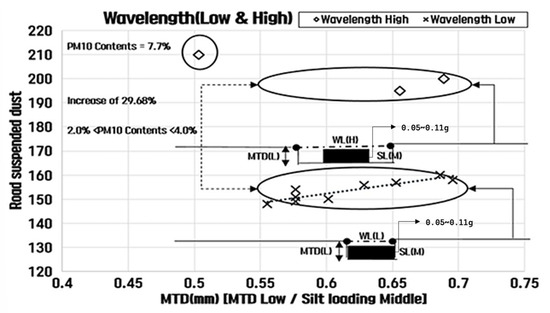
Figure 16.
Correlation of level of wavelength with middle range of MTD and silt loading.
Moreover, when the dust load is high, particularly during MTD, the suspended dust concentration is significantly influenced by the wavelength. PM10 content, being the largest contributing factor, showed a similar pattern, where the wavelength played a role under similar conditions, as shown in Figure 17. In the analysis of suspended dust within the middle and high ranges of sL, it was observed that when the wavelength is low, the suspended dust concentration increases with higher sL values. However, this increase in dust concentration is also heavily dependent on the PM10 content. Further analysis revealed that in cases where the sL was high, the concentration of suspended dust was notably elevated. This suggests that not only does the sL level contribute to the dust concentration but also the interaction between the sL, PM10 content, and the wavelength also determines the extent to which suspended dust is generated. The relationship between these factors highlights the complexity of managing road dust, where controlling the wavelength could reduce dust suspension, especially in areas with high PM10 content and elevated sL levels (Figure 17).
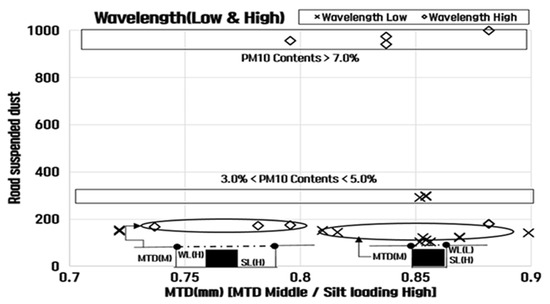
Figure 17.
Correlation of level of wavelength with suspended dust within MTD and silt loading.
However, the findings indicate that when MTD is within a mid-range, the impact of the surface wavelength on suspended dust concentration is negligible if the silt load (sL) remains low with the result of Figure 18. In this study, a low sL level was identified as 0.05 g/m2, corresponding to the dust load observed in the special metropolitan area of Seoul. This suggests that on urban roads with minimal dust accumulation, the surface wavelength may not be a critical factor influencing dust suspension. Conversely, when sL exceeds 1.0 g/m2—typically associated with industrial areas in South Korea [25]—suspended dust concentration significantly increases. In such cases, minimizing the surface wavelength becomes essential to mitigating dust emissions. This can be achieved by reducing the peak height of surface texture, specifically by minimizing the gap between aggregates in asphalt pavement. Implementing this approach could serve as an effective strategy for managing suspended dust levels based on road dust load conditions.
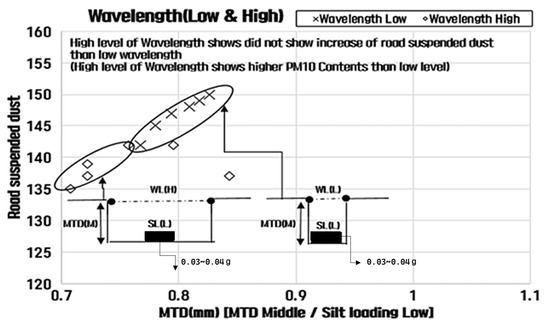
Figure 18.
Correlation of level of wavelength with low silt loading and middle range of MTD.
3.7. Relationship Between Silt Loading and PM10 Content (%) with Road-Suspended Dust
As observed in the analysis of Site A, where the PM10 content averaged 15%, even when both the MTD and sL were low, the suspended dust concentration remained high. This was particularly evident when both the PM10 content and the wavelength were high. The suspended dust generation mechanism related to the road surface texture can be attributed to the significant amount of dust that becomes suspended in the air due to the long wavelength.
This is caused by contact with the peak level of the road surface during the rotation of the tires, which enhances the dust suspension process. Moreover, the results indicated that the higher the MTD, the greater the amount of sL. In sections where the MTD was lower, it was found that as the MTD increased, the suspended dust concentration also increased, which is consistent with the findings shown in Figure 19. This suggests that the texture depth (MTD) plays a crucial role in the generation of suspended dust, particularly when considering the interaction between the road surface texture, tire contact, and dust load. Therefore, managing the MTD and wavelength is important for controlling road dust emissions, especially in areas with high PM10 content.
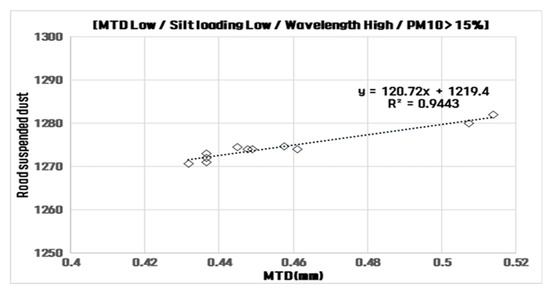
Figure 19.
Correlation of road-suspended dust in PM10 > 15% and wavelength > 4.
In Section A, despite the silt value being the lowest, the road-suspended dust concentration was the highest overall. This suggests that factors other than silt content, such as the texture depth (MTD) and dust load (sL), had a significant impact on dust levels. Figure 20 presents the analysis of suspended dust concentration in relation to sL at the same MTD level. When the PM10 content ranged from 2% to 4% in sections where the MTD was less than 0.7 mm, the dust concentration was found to be 20% higher when the sL was at a middle level, which reflects typical conditions found on urban roads. This indicates that the higher the sL value, the higher the concentration of suspended dust, emphasizing the importance of dust load in dust suspension.
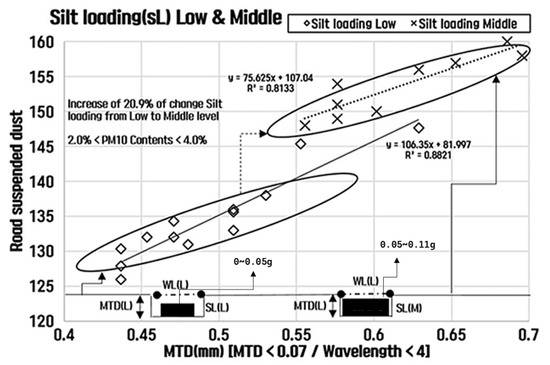
Figure 20.
Correlation of middle MTD with different silt loading.
Therefore, it is observed that the gap between aggregates increases with a longer wavelength [18], which creates more space for dust particles to become suspended in the air. This suggests that the wavelength has a significant effect on the concentration of suspended dust. Additionally, as a result of analyzing suspended dust according to both the high sL and high wavelength within the same MTD level, it was found that higher sL values correspond to a 20% increase in suspended dust concentration. This increase in dust concentration is believed to be influenced by the higher sL, which in turn affects the dust levels, despite maintaining similar PM10 content across the measurements. This reinforces the relationship between sL, wavelength, and the concentration of suspended dust, highlighting their combined impact on road dust emissions (Figure 21).
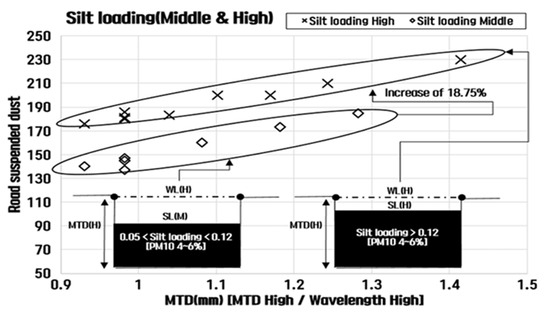
Figure 21.
Effects of road-suspended dust with different level of silt loading.
As a result of analyzing the concentration of suspended dust at the middle MTD level, it was found that sL values ranging from 0.05 to 0.08 g/m2 corresponded to a moderate level of suspended dust, while higher sL values between 0.08 and 0.12 g/m2 led to increased suspended dust concentrations. Moreover, elevated sL levels were associated with higher suspended dust levels. The analysis also revealed a distinct difference in suspended dust concentrations between sL values below 0.1 g/m2 and those exceeding 0.1 g/m2, indicating that sL plays a critical role in determining suspended dust.
At the highest MTD level, exceeding 1.7 mm, the concentration of road-suspended dust remained constant regardless of further increases in MTD expressed in Figure 22. This suggests that an MTD threshold of 1.7 mm effectively stabilizes middle-level sL, preventing dust from becoming airborne due to the deeper texture depth. Therefore, for managing road dust in areas with high sL levels, optimizing the MTD can serve as a practical strategy for mitigating suspended dust emissions. Analysis of road surface texture depth and wavelength cycles in asphalt pavement indicates that MTD and wavelength influence suspended dust levels differently under the same conditions. This variation is attributed to aggregate particle size, as both MTD and wavelength are strongly correlated with changes in aggregate size. Consequently, the influence of aggregate particle size on asphalt pavement is expected to be significant [12], with smaller maximum aggregate sizes leading to lower suspended dust levels. Furthermore, the analysis revealed that when the MTD is low and wavelength is high, the suspended dust concentration increases.
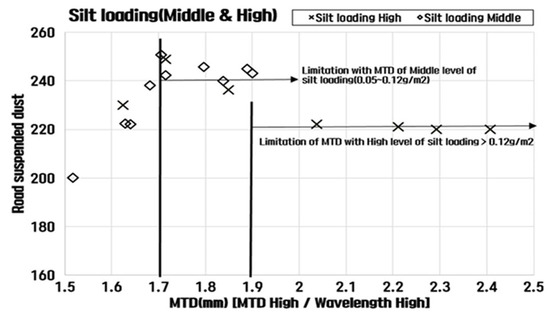
Figure 22.
Threshold of MTD (1.7 mm) with middle level of silt loading.
3.8. Mechanism of Road-Suspended Dust with Different Types of Asphalt Pavement
Based on the data of measured dust concentration by suspended dust influencing factors, correlation analysis was conducted to identify the correlation between each variable and examine the linearity and independence. Correlation analysis is a method of analyzing the linear relationship between two variables, and it is characterized by using the coefficient to determine the degree of relationship, which is generally expressed as the Pearson correlation coefficient. It has a value between −1 and 1, and if it is close to −1, it is a negative correlation, and if it is close to 1, it is a positive correlation, and if the absolute value is close to 0, it can be seen as almost no correlation. In general, if the absolute value of the correlation coefficient is above 0.8, it means a strong correlation, if it is between 0.8 and 0.4, it means a moderate correlation, and if it is below 0.4, it means a weak correlation. In this case, Right MTD was selected because it has a high correlation with suspended dust concentration. The correlation analysis, as shown in Table 5, shows that road-suspended dust concentration in concrete pavement is correlated with all variables except wetness to some extent, and the correlations between the variables are all weaker than 0.5 except wavelength, so it can be inferred that independence exists. However, in this study, we want to analyze the interaction effect to determine whether there is an interaction between the factors affected by road-suspended dust.

Table 5.
Results of statistical analysis between road-suspended dust factors in pavement.
The results of multi-regression analysis by influencing factors on the mechanism of suspended dust generation in asphalt pavement is shown in Table 5. The p-value was calculated to be less than or equal to 0.05 with 95% confidence, so the results of this regression analysis are considered statistically significant. The t-statistic is an indicator of whether the regression coefficient of each independent variable is statistically significant, and the larger the absolute value of the t-statistic, the greater the impact of the independent variable on the dependent-187 variable. In general, a t-statistic is known to be significant if the absolute value of the t-statistic is greater than or equal to 2. Therefore, based on the t-statistic, wavelength and the MTD were found to be the largest variables explaining suspended dust for concrete and asphalt pavement for each. In the case of wavelength, there is still no officially approved standard like texture depth, but from this study, the importance of wavelength can be a factor for the generation of road-suspended dust. Based on the 95% confidence interval, it can be concluded that wavelength, sL, and PM10 content have a positive effect on the increase in road-suspended dust, while the MTD has a negative correlation. This is consistent with previous studies finding that the MTD of road texture reduces suspended dust concentration [6,7,26,27,31], and may suggest that considering PM10 content and wavelength in addition to analyzing sL as a single factor can predict concentration changes more accurately. The results of the analysis in this section show that the MTD related to road texture is related to suspended dust that slope of the trend line is negative for asphalt pavement. Moreover, sL * PM10 content are shows positive correlation, indicating that the higher the dust load and PM10 content, the higher the suspended dust.
Based on these findings, the mechanisms and results of suspended dust generation for asphalt pavement types were analyzed and summarized in Table 6. The analysis concludes that sL characteristics and dust concentration vary depending on MTD and aggregate size for each pavement type. This suggests that surface texture management, particularly controlling MTD and aggregate size, plays a crucial role in mitigating suspended dust emissions.

Table 6.
Finding principle of road-suspended dust related to various asphalt pavement.
4. Discussion
The impact of suspended dust on the road surface structure has not been fully explored. To address this, a schematic quantitative analysis was conducted in terms of microtexture and macrotexture. The findings suggest that pavements with rougher surface structures exhibit the highest friction coefficients, providing optimal friction and braking performance. However, further discussion is necessary to assess road-suspended dust from the perspective of road environmental factors, emphasizing the need for a comprehensive approach to pavement management and dust mitigation. It is summarized in Figure 23.
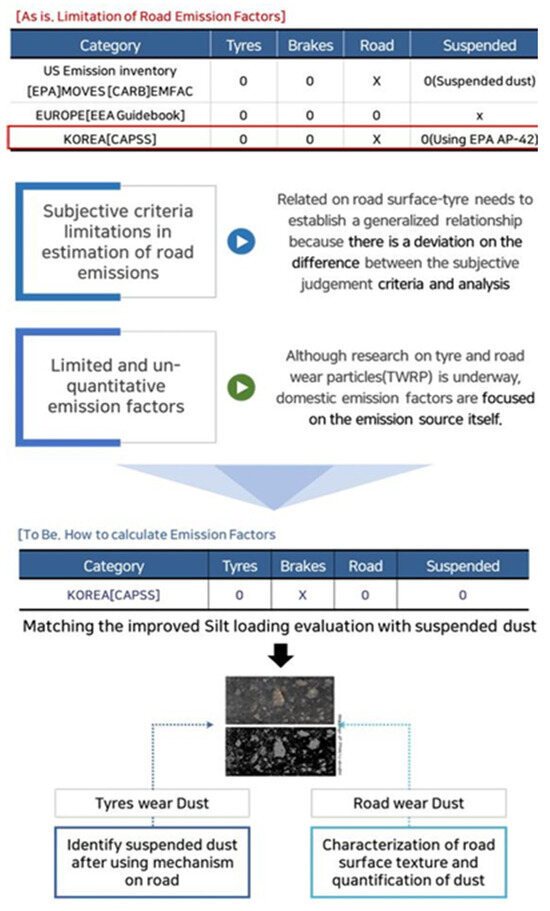
Figure 23.
Contribution and future work for this study.
While this study provides valuable insights into the relationship between surface texture and dust suspension, there are certain aspects that warrant further exploration. One key limitation is the lack of in-depth discussion on the mechanisms through which texture depth and surface wavelength influence dust resuspension. Although our results indicate that deeper textures lead to greater dust suspension, the aerodynamic effects and the detailed tire–road interactions that trigger dust resuspension remain areas for further study. In future research, incorporating more detailed models or simulations, such as computational fluid dynamics (CFD) or wind tunnel experiments, could help clarify the specific aerodynamic forces at play. These models could provide a deeper understanding of how different surface textures influence tire behavior and, in turn, contribute to dust suspension in various conditions. By addressing these aspects, future studies could enhance the theoretical framework and offer more precise predictions about how surface texture parameters, in combination with tire–road interactions, contribute to dust resuspension in real-world conditions.
5. Conclusions
Road dust suspension is a significant environmental issue that adversely affects air quality and public health. However, many existing models of road dust suspension are empirical and do not comprehensively represent various regions. The generation of suspended dust is influenced by road surface characteristics, including macrotexture depth (MTD), aggregate size, and surface wavelength. While previous studies have underscored the importance of road texture in dust generation, particularly through tire interactions, the precise relationship between MTD, surface wavelength, and dust concentration remains inadequately quantified, especially regarding thresholds for managing road dust suspension.
This study aimed to investigate the effects of MTD and surface wavelength on suspended dust generation in asphalt pavements. The analysis revealed a strong correlation between these factors, demonstrating that when the MTD is low and surface wavelength is high, suspended dust concentration increases significantly. However, when MTD exceeds 1.7 mm, dust concentration stabilizes, indicating a threshold that limits dust suspension. Additionally, higher silt load (sL) values above 0.1 g/m2 were associated with increased dust emissions, while reducing the surface wavelength effectively minimized dust suspension, particularly in environments with high dust loads.
Key findings include the following:
- Relationship between texture and road dust: the deeper the microtexture and long macrotexture distance, the greater the air-pumping and the force for momentary deformation on the surface with tire interactions that cause a high level of road-suspended dust.
- Type of asphalt pavement: In the case of HMA pavement in asphalt pavement, the deeper the texture depth, the higher the dust load and the higher the dust concentration, according to the results of the correlation analysis. However, in the case of porous pavement, despite the increased texture depth, dust decreased due to the voids between the pavement, showing the lowest dust concentration value in asphalt pavement.
- Threshold for Dust Control: When the MTD exceeds 1.7 mm, the suspended dust concentration stabilizes, suggesting that a deeper macrotexture can help contain dust particles and prevent their release into the air. With the level of sL, the limitation with an MTD of 1.7 mm can hold the sL of middle level and a 1.9 mm MTD can show the high level of sL of 0.12 g/m2. An optimal MTD in terms of suspended dust, and 1.2 mm in the lower sL section, 1.5 mm in the middle section, and 2 mm in the high section were measured as the section where road-suspended dust remained constant. At this time, since the section where the MTD is elevated appeared as a porous paving of asphalt pavement, it is judged that an MTD value of at least 1.5 mm is required for road dust management.
- Impact of Surface Wavelength: Longer surface wavelengths correlate with increased suspended dust, as greater gaps between aggregate peaks enhance air-pumping effects during tire interactions. But a high level of wavelength did not show an increase in road-suspended dust compared to the wavelength when the sL is low.
- Effect of Dust Load (sL) on Suspension: higher sL values (above 0.1 g/m2) significantly increase dust emissions, emphasizing the need for targeted dust control measures in areas with high particulate accumulation.
These findings highlight the need to optimize road surface texture to mitigate suspended dust emissions. The proper management of aggregate size and surface wavelength can play a crucial role in controlling airborne dust, particularly in urban environments with high particulate matter concentrations. Furthermore, while rougher road surfaces enhance friction and braking performance, their role in dust suspension warrants further investigation. Future research should explore the long-term environmental implications of road surface modifications and develop additional mitigation strategies to balance road safety and air quality concerns.
Author Contributions
Conceptualization, H.-J.Y. and I.-T.K.; methodology, S.-J.H. and J.-Y.C.; investigation, H.-J.Y.; data curation, S.-J.H.; writing—original draft preparation, H.-J.Y.; writing—review and editing, J.-Y.C.; visualization, H.-J.Y.; supervision, I.-T.K.; funding acquisition, I.-T.K. All authors have read and agreed to the published version of the manuscript.
Funding
This work was supported by a Korea Agency for Infrastructure Technology Advancement (KAIA) grant funded by the Ministry of Land, Infrastructure, and Transport (grant number 21POQWB152342-03).
Institutional Review Board Statement
Not applicable.
Informed Consent Statement
Not applicable.
Data Availability Statement
The urban weather observation data from the Automated Synoptic Observing System (ASOS) were provided by the Korea Meteorological Administration (KMA) and are available online: https://data.kma.go.kr. (accessed on 23 May 2023, 18 June 2023 and 9 July 2023).
Acknowledgments
The authors would like to thank the members of the research team, KAIA, and MOLIT for their guidance and support throughout this project.
Conflicts of Interest
Author Ho-jun Yoo was employed by the company RoadKorea Inc. The remaining authors declare that the research was conducted in the absence of any commercial or f inancial relationships that could be construed as a potential conflict of interest. The authors declare no conflicts of interest.
References
- Pope, C.A.; Thun, M.J.; Namboodiri, M.M.; Dockery, D.W.; Evans, J.S.; Speizer, F.E.; Heath, C.W. Particulate air pollution as a predictor of mortality in a prospective study of US adults. Am. J. Respir. Crit. Care Med. 1995, 151, 669–674. [Google Scholar] [CrossRef] [PubMed]
- Askariyeh, M.H.; Venugopal, M.; Khreis, H.; Birt, A.; Zietsman, J. Near-road traffic-related air pollution: Resuspended PM2.5 from highways and arterials. Int. J. Environ. Res. Public Health 2020, 17, 2851. [Google Scholar] [CrossRef] [PubMed]
- Lewis, A.; Moller, S.J.; Carslaw, D. Non-Exhaust Emissions from Road Traffic. 2019. Available online: https://eprints.whiterose.ac.uk/156628/ (accessed on 27 July 2022).
- Rienda, I.C.; Alves, C.A. Road dust resuspension: A review. Atmos. Res. 2021, 261, 105740. [Google Scholar] [CrossRef]
- Denby, B.R. A coupled road dust and surface moisture model to predict non-exhaust road traffic induced particle emissions (NORTRIP). Part 1: Road dust loading and suspension modelling. Atmos. Environ. 2013, 77, 283–300. [Google Scholar] [CrossRef]
- Lundberg, J.; Blomqvist, G.; Gustafsson, M.; Janhäll, S. Texture influence on road dust load. In Proceedings of the 22nd International Transportation and Air Pollution Conference, Zürich, Switzerland, 15–16 November 2017. [Google Scholar]
- Blomqvist, G. Road surface dust load is dependent on road surface macro texture. Atmos. Environ. X 2013, 2, 28. [Google Scholar]
- Amato, F. Impact of traffic intenstsity and pavement aggregate size on road dust particles loading. Atmos. Environ. 2013, 77, 29. [Google Scholar] [CrossRef]
- China, S. Effects of Pavement Macrotexture on PM10 Emissions from Paved Roads. Master′s Thesis, University of Nevada, Las Vegas, NV, USA, 2008. [Google Scholar]
- China, S. Influence of pavement macrotexture on PM10 emissions from paved roads: A controlled study. Atmos. Environ. 2012, 63, 313–326. [Google Scholar] [CrossRef]
- Svensson, N. Effects of a porous asphalt pavement on dust suspension and PM10 concentration. Transp. Res. Part D 2023, 123, 103921. [Google Scholar] [CrossRef]
- Hong, S.J. Relationship Between Tyres-Pavement Noise and Surface Texture. Ph.D. Thesis, Gangneung–Wonju University, Gangneung-si, Republic of Korea, 2015. [Google Scholar]
- Kim, J.H. Effects of Pavement Texture Characteristics on Tyres—Pavement Interaction Noise. Ph.D. Thesis, Gangneung–Wonju University, Gangneung-si, Republic of Korea, 2023. [Google Scholar]
- Zhang, W.; Ji, Y.; Zhang, S.; Zhang, L.; Wang, S. Determination of silt loading distribution characteristics using a rapid silt loading testing system in Tianjin, China. Aerosol Air Qual. Res. 2017, 17, 2129–2138. [Google Scholar] [CrossRef]
- Li, D.; Chen, J.; Zhang, Y.; Gao, Z.; Ying, N.; Gao, J.; Zhang, K.; Zhu, S. Dust emissions from urban roads using the AP-42 and TRAKER methods: A case study. Atmos. Pollut. Res. 2021, 12, 101051. [Google Scholar] [CrossRef]
- Johansson, C. PM10 Emission Från Betongbeläggning (PM10 Emission from Concrete Pavement in Swedish); Report No: 192.; Stockholm University: Stockholm, Sweden, 2009. [Google Scholar]
- Chung, C.H.; Park, J.H.; Hwang, S.M.; Jeong, Y.G. Comparison of PM10 mass concentration in different measurement methods and meteorological conditions. Part. Aerosol Res. 2009, 5, 53–62. [Google Scholar]
- Moon, S.B.; Lee, S.W.; Kim, J.H.; Kim, Y.K. Characterization of coarse aggregate amounts on a road surface of fine-size exposed aggregate concrete pavement for tyres-pavement noise reduction. Int. J. Highw. Eng. 2019, 21, 27–33. [Google Scholar] [CrossRef]
- Lyhour, C. Computer Vision and Photogrammetry-Aided for Exposed Aggregate Concrete Pavement Surface Texture Evaluation. Ph.D. Thesis, Gangneung–Wonju University, Gangneung-si, Republic of Korea, 2022. [Google Scholar]
- ASTM E965; Standard Test Method for Measuring Pavement Macrotexture Depth Using a Volumetric Technique. ASTM: West Conshohocken, PA, USA, 2006.
- U.S. Environmental Protection Agency. Environmental Protection Agency Compilation of Air Pollution Emission Factors, AP-42, 5th ed.; U.S. Environmental Protection Agency: Washington, DC, USA, 2003; Volume I: Stationary Point and Area Sources, Section 13.2.1 Paved Roads.
- U.S. Environmental Protection Agency. Emission Factor Documentation for AP-42, Section 13.2.1: Paved Roads; Policy Group, Office of Air Quality Planning and Standards: Washington, DC, USA, 2011.
- Hong, S.; Yoo, H.; Cho, J.; Yeon, G.; Kim, I. Characteristics of resuspended road dust with traffic and atmospheric environment in South Korea. Atmosphere 2022, 13, 1215. [Google Scholar] [CrossRef]
- Yoo, H.; Cho, J.; Hong, S.; Kim, I. Characteristics of suspended road dust according to vehicle driving patterns in an urban area and PM10 content in silt. Atmosphere 2024, 15, 5. [Google Scholar] [CrossRef]
- Han, S.H. A Study on the Emissions and Chemical Characteristics of Resuspended Dust from Paved Roads in Urban Areas. Ph.D. Thesis, Inha University, Incheon, Republic of Korea, 2012. [Google Scholar]
- Lundberg, J.; Gustafsson, M.; Janhall, S.; Eriksson, O.; Blomqvist, G.; Erlingsson, S. Temporal Variation of Road Dust Load and Its Size Distribution—A Comparative Study of a Porous and a Dense Pavement. Water Air Soil Pollut. 2020, 231, 561. [Google Scholar] [CrossRef]
- Lundberg, J.; Blomqvist, G.; Gustafsson, M.; Janhäll, S. Road Dust Load Dynamics and Influencing Factors for Six Winter Seasons in Stockholm, Sweden. Atmospheric Environment, 2019. Available online: https://www.researchgate.net/publication/330733227_Road_dust_load_dynamics_and_influencing_factors_for_six_winter_seasons_in_Stockholm_Sweden (accessed on 27 July 2022).
- Lundberg, J.; Janhäll, S.; Gustafsson, M.; Erlingsson, S. Calibration of the Swedish studded tyres abrasion wear prediction model with implication for the NORTRIP road dust emission model. Int. J. Pavement Eng. 2019, 22, 432–446. [Google Scholar] [CrossRef]
- Alber, S.; Ressel, W.; Liu, P.; Hu, J.; Wang, D.; Oeser, M.; Uribe, D.; Steeb, H. Investigation of microstructure characteristics of porous asphalt with relevance to acoustic pavement performance. Int. J. Transp. Sci. Technol. 2018, 7, 199–207. [Google Scholar] [CrossRef]
- Gustafsson, M.; Blomqvist, G.; Gudmundsson, A.; Dahl, A.; Jonsson, P.; Swietlicki, E. Factors influencing PM10 emissions from road pavement wear. Atmos. Environ. 2009, 43, 4699–4702. [Google Scholar] [CrossRef]
- Chen, S.; Liu, X.; Luo, H.; Huang, X. A state-of-the-art review of asphalt pavement surface texture and its measurement techniques. J. Road Eng. 2022, 2, 156–180. [Google Scholar] [CrossRef]
Disclaimer/Publisher’s Note: The statements, opinions and data contained in all publications are solely those of the individual author(s) and contributor(s) and not of MDPI and/or the editor(s). MDPI and/or the editor(s) disclaim responsibility for any injury to people or property resulting from any ideas, methods, instructions or products referred to in the content. |
© 2025 by the authors. Licensee MDPI, Basel, Switzerland. This article is an open access article distributed under the terms and conditions of the Creative Commons Attribution (CC BY) license (https://creativecommons.org/licenses/by/4.0/).
